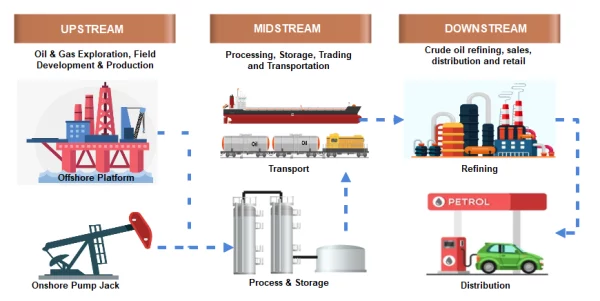Oil and gas upstream operations are a crucial component of the global energy industry, responsible for extracting and producing the fossil fuels that power much of the world’s economies. The upstream sector of the oil and gas industry refers to the exploration, drilling, and production activities that take place before oil and gas are transported to refineries and processing plants. In this blog, we will take a closer look at the oil and gas upstream operations, exploring the different stages involved, the technologies used, and the challenges facing the industry today.
Oil and Gas Upstream Activities
Upstream oil and gas activities are typically carried out by oil and gas companies, which invest significant resources into exploration and production efforts in order to find and extract oil and gas resources. These activities are often complex, and expensive and involve the use of advanced technology, specialized equipment, and highly skilled professionals.
Exploration tasks like making geological surveys and securing land rights, as well as production tasks like onshore and offshore drilling, are all part of the oil and gas industry’s upstream sector. The below diagram shows the oil and gas upstream, midstream and downstream operations.

1. Exploration
The first step in the upstream process is exploration. This involves identifying potential oil and gas reserves beneath the earth’s surface. Geologists and geophysicists use a range of techniques to locate these reserves, including seismic surveys, gravity and magnetic surveys, and exploration drilling. Seismic surveys involve sending sound waves into the earth and analysing the reflected waves to create an image of the subsurface rock formations. Gravity and magnetic surveys measure variations in the earth’s gravitational and magnetic fields, which can indicate the presence of hydrocarbon reserves. Exploration drilling involves drilling test wells to determine the presence and quality of oil and gas reserves.
2. Drilling
Once potential reserves have been identified, the drilling process can begin. Drilling is the process of creating a hole in the earth’s surface to extract oil and gas. There are two main types of drilling: vertical and horizontal. Vertical drilling involves drilling straight down into the earth, while horizontal drilling involves drilling at an angle to reach oil and gas reserves located in rock formations that are difficult to access. Drilling rigs are used to drill wells, and there are several types of rigs, including land-based rigs, offshore rigs, and subsea rigs.
3. Production
When a well is drilled, the next stage is to begin producing oil or gas. For this to happen, we must bring oil and gas up from the reservoir. Production techniques range from primary extraction through secondary processing and tertiary retrieval. The oil and gas are pushed to the surface by the reservoir’s inherent pressure during primary recovery. The oil and gas are “secondarily recovered,” or brought to the surface by increasing the pressure in the reservoir through the injection of water or gas. During tertiary recovery, oil and gas are extracted from the reservoir utilising innovative methods, such as steam injection.
4. Transportation
Once the oil and gas have been extracted from the well, they need to be transported to processing plants and refineries. Transportation can take place by pipeline, tanker, or truck. Pipelines are the most common method of transportation, as they are the most efficient and cost-effective way to move large quantities of oil and gas over long distances. Tankers are used for transporting oil and gas over water, while trucks are used for shorter distances or to transport smaller quantities.
Challenges Facing the Oil and Gas Industry
The oil and gas upstream sector faces several challenges today.
- One of the main challenges is the declining availability of easily accessible reserves. Many of the world’s largest oil and gas fields have already been discovered and are nearing depletion, making it increasingly difficult and expensive to find new reserves.
- Another challenge is the growing concern over the environmental impact of fossil fuel extraction and production. The industry is under pressure to reduce its carbon footprint and adopt more sustainable practices.
- Finally, the upstream sector faces increasing competition from alternative energy sources, such as wind and solar power, which are becoming more cost-competitive and gaining market share.

Technologies and Innovations
To address these challenges, the oil and gas upstream sector is adopting new technologies and innovations. One such innovation is hydraulic fracturing, also known as fracking. Fracking involves injecting water, sand, and chemicals into rock formations to release oil and gas trapped within the rock. While controversial due to its potential environmental impact, fracking has enabled the industry to access previously inaccessible reserves and has increased production in many areas.
Another innovation is the use of digital technologies in oil and gas upstream activities. Digital technologies, such as artificial intelligence
Safety in Upstream Oil and Gas Operations
Safety in upstream oil and gas operations is a critical concern, as the industry involves high-risk activities and hazardous materials. The safety of workers and the environment must be a top priority in all stages of upstream operations, from exploration to production and transportation.
Safety measures in upstream oil and gas operations include regular training and education for workers, the use of personal protective equipment, the implementation of safety protocols and procedures, and the monitoring of equipment and processes for potential hazards. The industry also relies on regulations and standards set by government bodies and industry organizations to ensure the safety of workers and the environment.





